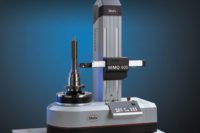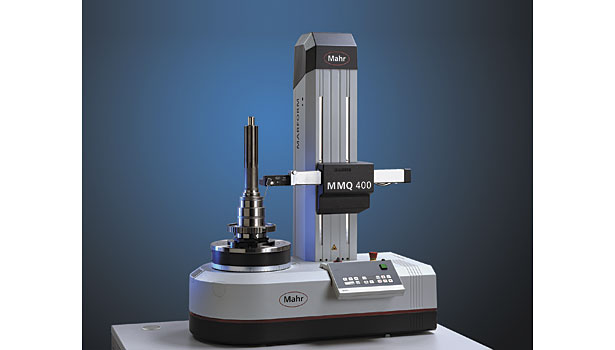When a Round Peg Is Just Too Square: The Basics of Harmonic Analysis
The technique of Fourier series, or harmonic analysis, has been applied to a wide array of problems, both mathematical and physical.






Most of the time form measurement looks at basic geometrical shapes: how round something is, how straight or even how flat it is. You measure a cylinder and make a trace up the side to see if it’s straight; you take a polar trace to see if it’s round; you combine a number of these traces to see if it’s cylindrical. All these are basic geometries: lines, planes, circles and cylinders.
But all of us have known since we got our first Fisher-Price play set that the square peg doesn’t fit in the round hole. And sometimes, round pegs don’t even fit in round holes. That is the reason for roundness specifications on many parts: to know if a round “peg” is round enough to fit into a round “hole” on parts being assembled. However, sometimes just knowing if it’s round isn’t good enough, either. In the real three-dimensional world where precision machined parts have to function, it might be important to understand how the shape of the errors in roundness will impact the desired function of the surface.
Take a round part that rolls along another surface, a roller bearing in a raceway for example. The round part could be almost perfectly round but still might not work properly. So a bearing manufacturer often doesn’t care about a simple roundness number. They want to look at how that roundness is composed. They want to see what shape the various out-of-roundness errors have, and what impact the wavelengths of those errors have on the bearing’s ability to function.
That’s what harmonic, often referred to as Fourier analysis, is all about. It allows us to break down, or deconstruct, a complex curve into a number of simple sine curves of different wavelengths and amplitudes that when added together approximate the original complex curve. The more of these sine curves we use, the better the approximation. It would take too long to go through the derivation of a Fourier series, but those of you not familiar with the concept should check out this page on Wikipedia: http://en.wikipedia.org/wiki/Fourier_series. You may feel intimidated by all the mathematical equations scattered about there, but you probably don’t need to bother with those (unless you want to): just look at the pictorial visualizations. They demonstrate the complex process of constructing a series of harmonically related sinusoidal functions with amazing simplicity, including the distribution of heat in a metal plate, which was Jean-Baptiste Joseph Fourier’s motivation for coming up with the technique back in 1807 (hence the name Fourier analysis).
Since then, the technique of Fourier series, or harmonic analysis, has been applied to a wide array of problems, both mathematical and physical. Fourier analysis allows bearing manufacturers to deconstruct a complex roundness profile and chart its component curves (see figure 1), where the amplitude of the various frequencies is compared to their wavelengths as expressed in undulations per revolution. In terms of the bearing rolling in the raceway noted above, the manufacturer might be able to tolerate a little more of long wavelength amplitude, but short wave error will make the bearing bounce along or chatter. So rather than put a single tolerance number on the total roundness, these manufacturers put a tolerance curve on the chart of amplitude vs. wavelength created from the Fourier analysis.
But harmonic analysis has increasing application outside of bearing manufacturing as well. While the preponderance of such applications involve round parts, Fourier series analysis can be used for straightness and flatness applications. In these cases, the charts deconstruct the various wavelengths, plotting amplitude vs. frequency per unit of length (see figure 2). This can be useful in detecting the presence—or absence—of repeating microstructural patterns on part surfaces.
A good example of this involves floatation bearings that utilize an etched or machined pattern of tiny channels on one surface that creates hydraulic or pneumatic lift when moved relative to the mating surface. The channels making up these patterns are very small, often only a few microns deep and wide. The manufacturer needs to verify that any variability in his process is within tolerance, but measuring all the channels individually would be very time consuming. Instead, by using Fourier analysis to superimpose a series of sine curves over a measurement trace across all of the channels (again, see the Wiki visualizations), it can be quickly seen whether the overall pattern has the right channel spacing (dominant wavelength) and depth (amplitude of dominant wavelength), and verify that the channels will function effectively as a unit.
Another common application is what’s known as “lead analysis” in shaft seals. Engines have lots of oil and fluids in them and shafts that have to go through bearings. These shafts and the seals they pass through all have some type of microstructures on their surfaces as a result of manufacturing. These could be tiny grooves left from the tip of a tool during a turning process or even tinier grooves created by a single grain of the abrasive in a grinding wheel. If any of those microstructures happen to look like a screw thread or an auger, it will tend to pump liquid through the seal as the shaft rotates. The result is an oil drip if there is an open side at one end of the seal, or oil mixing with coolant or vice versa if the seal is between internal chambers of the engine.
Form systems that do lead analysis usually do so without the user really needing to be aware of how the system is calculating the desired parameters. But one way that the software can calculate what is needed (and there are other methods as well) is by doing Fourier series analysis: it analyzes the complete topography of the shaft surface and looks for repeating patterns of these thread-like structures. If patterns exist, the system reports the spacing between the threads, the amplitude of their wavelengths, the volume of the structures, and their angles relative to zero degrees. If the angle is zero degrees, you know the structures go right around the shaft and won’t pump in either direction. If they are greater or lesser than zero, the volume calculation will give you an idea about how much leakage might result.
As manufacturing and measuring systems become more and more sophisticated, we are finding we can understand many things better in three dimensions than in simple terms of lines, circles, and planes. There are still plenty of applications where simply knowing that the peg is round enough to go into the round hole is good enough. But increasingly manufacturers need to know “what kind of round” the peg is, what the errors in the roundness look like, and how the components of that shape affect the function of the peg. For this, harmonic or Fourier series analysis is becoming an increasingly valuable tool.
Looking for a reprint of this article?
From high-res PDFs to custom plaques, order your copy today!










